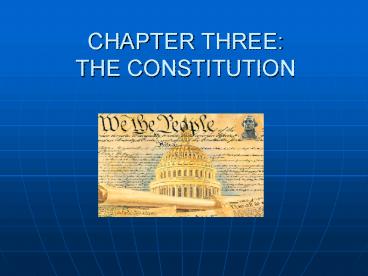CHAPTER THREE: THE CONSTITUTION - PowerPoint PPT Presentation
1 / 17
Title:
CHAPTER THREE: THE CONSTITUTION
Description:
CHAPTER THREE: THE CONSTITUTION - Article One: Legislative Branch - Article Two: Executive Branch ... each branch can 'check' the others, which in turn leads to ' ... – PowerPoint PPT presentation
Number of Views:74
Avg rating:3.0/5.0
Title: CHAPTER THREE: THE CONSTITUTION
1
CHAPTER THREE THE CONSTITUTION
2
OUTLINE OF THE CONSTITUTION
- - Article One Legislative Branch
- - Article Two Executive Branch
- - Article Three Judicial Branch
- - Article Four Relations among the States
- - Article Five Provisions for Amendments
- - Article Six National Debts, Supremacy
Clause, and Oaths - - Article Seven Ratification
3
THE SIX BASIC PRINCIPLES OF THE CONSTITUTION
- 1. Popular Sovereignty
- 2. Limited Government
- 3. Separation of Powers
- 4. Checks and Balances
- 5. Judicial Review
- 6. Federalism
4
THE SIX BASIC PRINCIPLES OF THE CONSTITUTION
- 1. Popular Sovereignty
- -- all power ultimately belongs to the people
- -- Preamble to the Constitution "We the
People of the United States...so ordain and
establish this Constitution for the United
States of America."
5
THE SIX BASIC PRINCIPLES OF THE CONSTITUTION
- 2. Limited Government
- -- social contract - government only has the
powers the people allow it to have - -- the "rule of law"
- -- Bill of Rights
6
THE SIX BASIC PRINCIPLES OF THE CONSTITUTION
- 3. Separation of Powers
- -- Presidential vs. Parliamentary System
- -- Articles I, II, and III
- 1. Legislative - Congress
- 2. Executive - President
- 3. Judicial - Courts
- -- Why separate the powers?
7
THE SIX BASIC PRINCIPLES OF THE CONSTITUTION
- 4. Checks and Balances
- -- three branches not entirely independent of
one another - -- each branch can "check" the others, which in
turn leads to "balance"
8
THE SIX BASIC PRINCIPLES OF THE CONSTITUTION
9
THE SIX BASIC PRINCIPLES OF THE CONSTITUTION
- 5. Judicial Review
- -- the power to decide whether a governmental
action is constitutional - -- held by Supreme Court and all federal courts
(and most State courts)
10
THE SIX BASIC PRINCIPLES OF THE CONSTITUTION
- - Marbury vs. Madison (1803)
- -- established power of judicial review
Chief Justice John Marshall
William Marbury
James Madison
11
THE SIX BASIC PRINCIPLES OF THE CONSTITUTION
- 6. Federalism
- -- power divided between National Government
and the 50 States - -- framers dealt with 13 highly independent
States - -- balance between tyranny of king and weak
central government under Articles of
Confederation
12
SECTION TWO AND THREE AMENDING THE CONSTITUTION
13
FORMALLY AMENDING THE CONSTITUTION
How Proposed
How Ratified
- 1. Proposed by CONGRESS by a 2/3 vote in both
houses
2. Proposed at NATIONAL CONV. called by Congress
when requested by 2/3 (34) State Legislatures
14
FORMALLY AMENDING THE CONSTITUTION
How Proposed
How Ratified
1. Ratified by the State LEGISLATURE in 3/4 (38)
of the States
2. Ratified by CONVENTIONS in 3/4 (38) of the
States
15
FORMALLY AMENDING THE CONSTITUTION
How Proposed
How Ratified
- 1. Proposed by CONGRESS by a 2/3 vote in both
houses
1. Ratified by the State LEGISLATURE in 3/4 (38)
of the States
2. Proposed at NATIONAL CONV. called by Congress
when requested by 2/3 (34) State Legislatures
2. Ratified by CONVENTIONS in 3/4 (38) of the
States
16
FORMALLY AMENDING THE CONSTITUTION
How Proposed
How Ratified
- 1. Proposed by CONGRESS by a 2/3 vote in both
houses
1. Ratified by the State LEGISLATURE in 3/4 (38)
of the States
2. Proposed at NATIONAL CONV. called by Congress
when requested by 2/3 (34) State Legislatures
2. Ratified by CONVENTIONS in 3/4 (38) of the
States
17
INFORMAL AMENDMENT
- 1. Basic Legislation (CONGRESS)
- 2. Executive Action (PRESIDENT)
- 3. Court Decisions (SUPREME COURT)
- 4. Party Practices (POLITICAL
- PARTIES)
- 5. Customs
18
FORMALLY AMENDING THE CONSTITUTION
How Proposed
How Ratified
- 1. Proposed by CONGRESS by a 2/3 vote in both
houses - 2. Proposed by CONGRESS by a 2/3 vote in both
houses - 3. Proposed at NATIONAL CONV. called by Congress
when requested by 2/3 (34) State Legislatures - 4. Proposed at NATIONAL CONV. called by Congress
when requested by 2/3 (34) State Legislatures
1. Ratified by the State LEGISLATURE in 3/4 (38)
of the States 2. Ratified by CONVENTIONS in 3/4
(38) of the States 3. Ratified by the State
LEGISLATURE in 3/4 (38) of the States 4.
Ratified by CONVENTIONS in 3/4 (38) of the States































